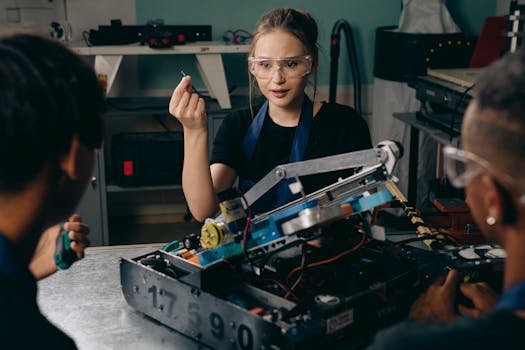Unlocking Cognitive Potential: A Neuroscientist's Guide to Optimized Learning
Traditional pedagogical approaches frequently disregard the brain's intricate architecture. We're diligently instructed on subject matter, yet rarely equipped with strategies for optimal knowledge acquisition. This significant oversight represents a colossal missed opportunity. Let's dissect the neural mechanisms to effectively optimize our cognitive machinery for lifelong intellectual growth.
1. Memory Solidification: The Synergistic Effects of Sleep and Iterated Rehearsal: Envision the brain as a master sculptor, painstakingly refining a block of Carrara marble. Newly acquired information initially possesses a precarious, ephemeral quality, akin to freshly etched details. Sleep serves as the crucial catalyst for "setting" these delicate inscriptions—transmuting memories from volatile, short-term repositories into robust, long-term archives. During slumber, the brain meticulously replays and fortifies newly encoded data. Spaced repetition cleverly capitalizes on this inherent process. Rather than engaging in unproductive cramming, review the material at progressively lengthening intervals—this elegantly mirrors the brain's intrinsic consolidation rhythm, guaranteeing superior retention. More on memory consolidation and sleep
2. Neural Plasticity: The Brain's Dynamic Adaptive Capacity: The brain is not a static entity; its remarkable adaptability is a testament to its inherent plasticity. Neuroplasticity, the brain's capacity for self-reorganization through the genesis of novel neural pathways, unfolds throughout the entire lifespan. Consider your brain a vibrant, ever-expanding neural forest. Learning generates new pathways, strengthens pre-existing connections, and even judiciously prunes underutilized ones. To nurture this neuroplasticity, enthusiastically embrace novel challenges, actively pursue diverse learning avenues, and engage in activities that robustly stimulate cognitive functions. Learn more about neuroplasticity
3. Context-Dependent Encoding: The Environmental Influence on Retrieval: Recall struggling to dredge up a specific detail, only to achieve effortless recollection upon returning to the original learning environment? This phenomenon underscores context-dependent encoding: the closer the learning milieu mirrors the retrieval environment, the more efficient the recall. Analogously, searching for a specific file requires knowing its precise directory; similar precision is needed for memory recall. Therefore, strategically vary your study locations to reflect the anticipated application of the knowledge or meticulously reconstruct the testing setting during preparation.
4. Active Retrieval: Fortifying Neural Networks Through Deliberate Recall: Passive rereading constitutes an ineffective learning strategy. Active recall compels the brain to actively retrieve information, significantly strengthening the underlying neural architecture. Imagine attempting to assemble an intricate jigsaw puzzle without consulting the image—this strenuous effort fortifies comprehension of the individual pieces and their interrelationships. Regularly quiz yourself, become a teacher, explaining concepts to another, or proactively engage in targeted retrieval exercises to comprehensively solidify learning.
5. Interleaved Learning: Optimizing Knowledge Acquisition Through Varied Exposure: Instead of focusing monolithically on a single topic, strategically switch between disparate subjects. This interleaving technique enhances learning by obligating the brain to discriminate between distinct concepts, thereby improving both encoding and retrieval processes. This resembles a weight training regime targeting different muscle groups; the varied approach bolsters the brain's overall cognitive resilience. Incorporate interleaving into your study schedule or integrate diverse skill sets within a complex project. Research on interleaved learning
6. Affective Engagement: The Power of Intrinsic Motivation: Learning transcends the purely cognitive; it's deeply interwoven with emotional experience. Passion ignites the release of neurochemicals that significantly amplify memory and learning efficacy. Infuse your learning with emotional resonance by connecting it to your personal aspirations, values, and inherent interests. This will markedly enhance both the potency and longevity of knowledge retention.
Unlocking Cognitive Potential: A Neuroscientist's Guide to Optimized Learning
Lifelong learning isn't just a desirable trait; it's a cognitive imperative, and understanding its neurological underpinnings is the key. Ignoring the brain's inherent architecture in the pursuit of knowledge is akin to navigating a complex city without a map – inefficient and frustrating.
1. Mastery of Complex Material: Forget struggling with impenetrable concepts. Neuroscience-informed strategies dismantle the barriers to complex subject mastery. Harnessing your brain’s innate capacity for information processing transforms challenging material into manageable, even engaging, intellectual conquests.
2. Accelerated Skill Acquisition: Imagine a learning trajectory that's not a relentless uphill battle, but a streamlined, efficient ascent. By optimizing your learning processes based on neurological principles, you'll achieve proficiency in essential skills at an unprecedented pace – a demonstrably faster and more effective acquisition of expertise.
3. Resilience in the Face of Change: In our ever-evolving world, adaptability is paramount. Neuroscience offers the tools to cultivate a growth mindset – the bedrock of continuous learning and development. This adaptability empowers you to thrive, not simply survive, amid constant transformation.
4. Enhanced Cognitive Retention and Recall: Information will no longer vanish like ephemeral wisps of smoke. Instead, using brain-based learning strategies fosters deep, enduring comprehension. You'll achieve profound and persistent knowledge retention, ensuring long-term mastery.
5. Elevated Problem-Solving Prowess: A deeper grasp of cognitive processing equips you with sophisticated tools for critical analysis and innovative problem-solving. You'll navigate challenges with enhanced dexterity, uncovering solutions others might miss, demonstrating superior intellectual agility.
6. The Joy of Learning: Learning shouldn't be a chore; it should be a source of intellectual stimulation and satisfaction. Understanding your brain's learning mechanisms transforms the process itself, fueling a self-reinforcing cycle of engagement, achievement, and sustained motivation.
Let's consider some potent analogies: Picture an architect constructing a skyscraper without understanding structural integrity. The outcome would be catastrophic. Equally, attempting to learn without understanding the brain's intricate workings invites frustration and limited results. A neuroscience-informed approach provides the structural blueprint for a robust and enduring knowledge edifice.
Alternatively, think of your brain as a finely-tuned, high-octane engine. Would you operate it at peak performance without understanding its mechanics? Of course not! Similarly, leveraging your understanding of the neuroscience of learning allows you to optimize your cognitive engine for maximum efficiency and performance, extracting unparalleled intellectual gains.






